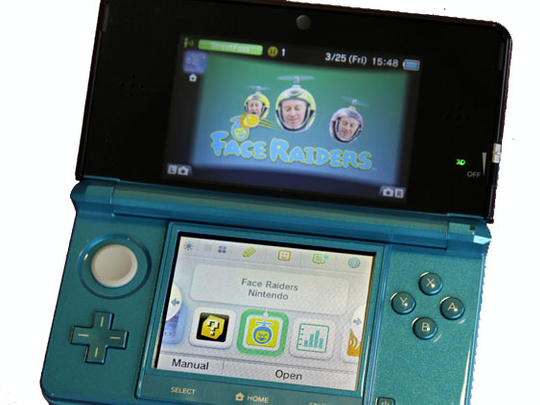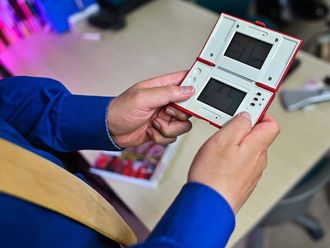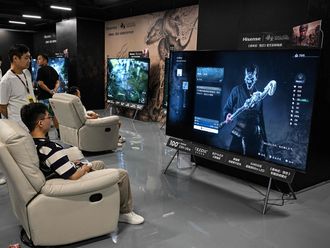
When historians of the future look back on the emergence of 3D home entertainment, they may well point out Nintendo's new handheld console as the minute it all went mainstream.
Revealed amid much hype and fanfare at the E3 event in Los Angeles, the Nintendo 3DS has become one of the most hotly anticipated games machines in history, attracting more than 100,000 pre-orders in the UK alone.
But what is glasses-free 3D actually like, and what else does this chunky box of tricks have to offer? Well, let's flip one open and have a darn good look
The hardware
There's no getting away from it, boasting a diminutive dual-screen clamshell design and a handy stylus for the touch-sensitive lower display, the Nintendo 3DS looks an awful lot like the Nintendo DS. It's slightly heavier and a bit smaller than the DSi and has a rather tacky gloss finish, which makes it look even more toy-like, but this is very much yanked from the same mould as the manufacturer's previous hand-held series.
Inside, there are some important changes to the controller set-up. On the left of the bottom screen is the new analogue thumb pad, which slides pleasingly around, providing a greater array of movements than the old cross-shaped DS d-pad.
This works especially well with games that offer a full 360 degrees of movement, like the flight sim Pilotwings Resort. Also, just in case you need it, the 3DS does have a d-pad too, though it is tiny and a bit awkward for those of us with thumbs like sausages.
On the right are the usual Y, X, B and A buttons for gaming, while other functions like Select and Start have been moved under the screen along with a new Home button, which returns you to the 3DS main menu, pausing your game or application while you're there. The whole system handles a lot more like the PS3 XMB or Xbox 360 menu or, indeed, a smartphone, and it's clearly an attempt to make the 3DS feel more grown-up and multi-functional.
Around the sides, you'll find an SD card slot (perfect for saving photos, music and other stuff),a slot for game carts (it'll play both 3DS and DS titles),a stylus port for the system's neat telescopic pointer, two really small shoulder buttons and a headphones socket. On the right side of the upper screen there's a slider control, allowing users to adjust the intensity of the 3D effect. You can move it all the way down to 2D if you fancy, which is handy if you do start suffering from stereoscopic sickness, or if you want to hand it over to your kids to play (Nintendo recommends that children under six do not play 3D titles.)
The technology
There's not a huge amount of information available about the tech specs of the 3DS, though it uses an ARM processor (just like most smartphones and Sony's forthcoming NGP console) and features a motion sensor and gyroscope for movement controls. The 3.5-inch top screen offers a resolution of 800 x 240, but because of the way the 3D technology works, it's actually 400 x 240 twice: each scene is rendered twice - one for each eye.
The 3DS employs a parallax barrier set-up, which consists of an LCD display overlaid by a film lined with precise slits which direct slightly different images to the left and right eye. You need to hold the device directly in front of your face, at comfortable reading height, to get the most out of the effect. While it copes with the odd jerk of a moving bus or train, shifting less than a centimetre out of the sweet spot can be enough to make the image to go flat and blurry, especially with games that use a larger depth of field.
When it's all lined up correctly, however, the stereoscopic visuals are immediately obvious, and can be rather magical. In Ridge Racer, helicopters and airplanes zoom overhead with convincing height and speed, while in Nintendogs, the animals tumble up and paw the screen, almost nodding their furry little heads out of it. We've also enjoyed the new behind-the-shoulder view in Street Fighter 4 3DS, which gets you right into the blood, sweat and hadoukens.
Right now, most games are more comfortably geared toward ‘concave' 3D, where the stereoscopic effect extends into the screen, rather than thrusting objects beyond it, but we'll see how it goes. Finally, although some players have complained of sore eyes and headaches after prolonged sessions, it's not something we've encountered. Taking a break every half hour or so seems a sensible precaution.
The connectivity
The 3DS features built-in Wi-Fi, allowing users to connect to the internet from any nearby hotspot or wireless router. As with the Nintendo DS, there will be an online store or eShop where players can buy downloadable games. A new version of the Wii's Virtual Console provides access to retro Game Boy and Game Boy Color classics, which should please old school Nintendo fans.
The 3DS can also play downloadable DsiWare titles, and you'll be able to transfer games you've already bought from the DsiWare shop onto your new 3DS. There's no web browser yet, but one is due later this year based on the Access Netfront platform. Apparently, you'll be able to access it mid-game, pausing the action to check the footie scores (or an online game cheat, you sneaky thing), before going back in.
There are two neat little communication extras. ‘Spot Pass' automatically connects the console to any nearby hotspot, allowing it to download game data, firmware updates and other extras, even when it's in sleep mode and tucked in your pocket. ‘Street Pass' constantly looks for nearby 3DS owners and will then exchange game items, high scores and Mii avatars with their machines.
Several games are set to support the Street Pass function: Street Fighter IV, for example, provides each player with a small set of digital figurines when you pass another SF IV owner, your figures fight each other and the winner gets an addition to their collection. It's Pokemon meets conkers. This is fascinating stuff, potentially turning any walk down the shops into an item-swapping, high-score-comparing bonanza.
The batteries
Nintendo estimates that you'll get three to five hours of play out of a single battery charge, though most players, including us, are finding the longevity to be at the lower end of that scale when 3D is turned right up. It's not great, but then, the poor machine is rendering the same scene at twice as many frames a second. If you're playing Nintendo DS titles you can expect much more gaming time for your buck.
The games
The titles to be launched vary from country to country, but here is a list of the main titles: Pilotwings Resort; Nintendogs + Cats: (Golden Retriever, French Bulldog and Toy Poodle editions); Super Street Fighter IV 3D Edition; The Sims 3; Pro Evolution Soccer 2011 3D; Lego Star Wars III: The Clone Wars; Ridge Racer 3D; Super Monkey Ball 3D; Samurai Warriors: Chronicles; Asphalt 3D; Tom Clancy's Ghost Recon: Shadow Wars; Tom Clancy's Splinter Cell 3D; and Rayman 3D
As you can see, the only first-party Nintendo titles are Pilotwings Resort and Nintendogs + Cats (US gamers are also getting the submarine game, Steel Diver, but Europeans are being left out). The highlights from the third-party range are PES, Ridge Racer and Super Street Fighter IV 3DS.
The console also comes pre-loaded with a range of mini-games and apps. Face Raiders is a rather basic augmented reality shooter that takes your photo and then gets you to blast at flying representations of your own face which appear to zoom around your room - a sort of nightmare rendered into a light-hearted camera game.
There's also Mii Maker, which lets you make Mii avatars to put into your 3DS games (though you can also import a Mii from your Wii, via an SD card).
Then there's Mii Plaza, a little hub that displays all the Miis you've met via the Street Pass feature, and a collection of little AR games that work with the six cards included with your console. Simply select a card, point your 3DS camera at it, and a game erupts into action before your very eyes. It's basic stuff, but it hints at what developers might be able to do when they start exploring the technology.
Oh and when in sleep mode, the 3DS acts as a pedometer, which (like a similar feature in Pokemon HeartGold/SoulSilver) provides virtual coins when you reach certain distances. These coins can then be used to buy items in compatible games. You see, says Nintendo, we're encouraging people to get fit! By gaming!
The entertainment
Alongside 3D games, Nintendo's console will also be able to play 3D movies though the details here are rather sketchy. At the European 3DS launch event recently, the company mentioned that Eurosport would be providing downloadable sports content, and that Sky would be bringing some 3D clips to the platform.
Aardman Animation, the creator of Wallace & Gromit, also revealed that it would be releasing a new series of one-minute Shaun the Sheep animations for the console.
Warner Bros, Disney and DreamWorks have all signed up to bring 3D movies over to the system, though no timeframe has been announced.
The camera
The 3DS features an inward-facing camera and two outward-facing lenses so that it can capture stereoscopic pictures all in a not-very-impressive 0.3 megapixel resolution (but then, you're not coming to a Nintendo console for those gorgeous arty sunsets).
The 3D photos are a lot of fun, closely resembling the images on an old Viewmaster - that is, objects look like variously placed cardboard cut-outs. It's a quaint effect, spoiled only by the fact that you can only share the images by gathering everyone around your console (or giving them to another 3DS owner on an SD card).
There's also a range of special effects including Sparkle, which adds a flowery stardust effect to photos when you blow into the mic (seriously) and Merge, which takes a photo of one person using the inside camera and another person on the outside camera and then ‘merges' the result into one new person... great for couples considering starting a family.
As with the DS, it's also possible to customise photos you've already taken with lots of silly items. There's no video facility yet, but it could well come in a software update.












